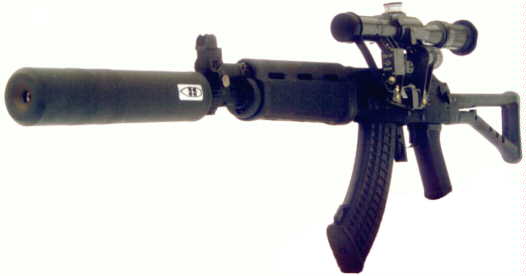 In Defense of Finnish Assault Rifle Production
In Defense of Finnish Assault Rifle Production
Text: Robie Kulokivi
SAKO, Finland -since the early 1960's a high quality sporting arms manufacturer
has been deeply involved in developing and producing the basic weapon for the Finnish
soldier, the 762 RK 62 assault rifle. A joint effort of the Finnish Defense Forces (FDF)
and Sako over several years brought a new product improved model to daylight very
recently, and this rifle was officially adopted as the 762 RK 95 TP. After the initial
order by FDF (worth some 16 Million USD) for the new M95 and spare parts, no follow up
orders have been planned, nor does there seem to he any funding for future orders. Sako
delivered the last assault rifles to the FDF during 1997 and after that the production
line will be closed. This in turn means that the production knowledge will eventually
disappear and after only a few years it would he difficult to start producing again. Is
Finnish assault rifle production "finished" for good?
Sako; arms factory production from a military viewpoint
The commercialization of the Civil Guard Supreme Staff Gun Works in Helsinki city, the
capital of Finland, on 1 April 1921 was the starting point for the 76 year old company
that we know today as SAKO. Suojeluskuntain Ase- ja Konepaja Osakeyhtiö
(Civil Guard Gun- and Machiningworks Ltd) was formed on 1 June 1927 from the previous
Civil Guard Supreme Staff Gun Works. After that re-organization the plant was moved from
Helsinki to Riihimäki city. The Civil Guard was a militarily led volunteer organization
apart from, but co-working with the FDF. The organization was abolished in 1945 after the
last Finnish wars.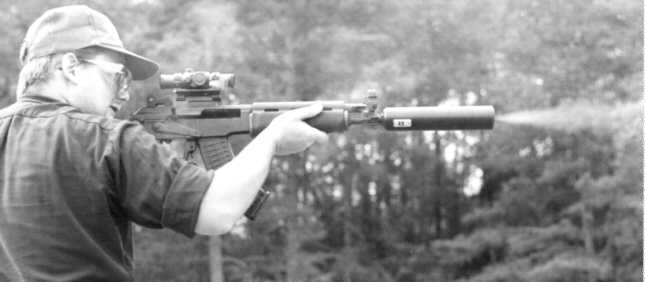
During the 1 930's there were several large projects in both construction and maintenance
of small arms. The main departments included machining, cartridge, barrel, and woodwork
shops. One of the more important products by SAKO at the time was the 7.62 M28-30 bolt
action rifle, a greatly improved Mosin-Nagant done produced until 1941. Production
exceeded 70,000 units. It is worth noting that this is the very same model that was used
in the 1937 World Shooting Championships in Helsinki.
The M95 (above) with a TR8
suppressor and accessory optical sight compared to SAKO manufactured M62 assault rifle
(below), the preceding model shown during Suppressor Project
accuracy tests equipped with a PSO-1 scope and a TX8 suppressor.
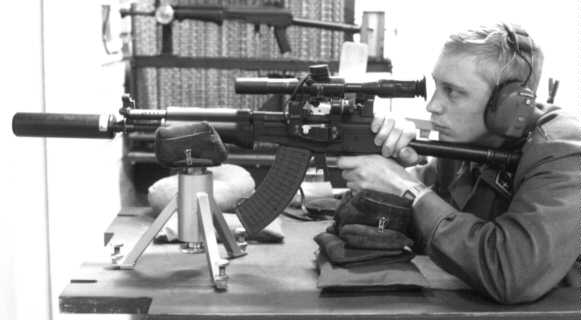 During the early fifties much of the effort went
into servicing material after the war as well as to regaining the civilian markets. The
FDF started planning the next generation of infantry weapon and asked both SAKO and Valmet
(formerly VKT), a state owned company, to produce prototypes. After some experimentation,
the Valmet M58 assault rifle in caliber 7.62x39mm was accepted as a test-bed for future
trials. FDF requested offers from both Valmet and SAKO for a prototype batch consisting of
200 rifles. Valmet won the contract and delivered 200 units of 762 RK 60 assault rifles
for field trials in late 1960. Based on the information gathered from those trials
specifications for the M62 were written down and prototype rifles produced. Special
cold-hammered barrels were ordered from SAKO for the new test models.
During the early fifties much of the effort went
into servicing material after the war as well as to regaining the civilian markets. The
FDF started planning the next generation of infantry weapon and asked both SAKO and Valmet
(formerly VKT), a state owned company, to produce prototypes. After some experimentation,
the Valmet M58 assault rifle in caliber 7.62x39mm was accepted as a test-bed for future
trials. FDF requested offers from both Valmet and SAKO for a prototype batch consisting of
200 rifles. Valmet won the contract and delivered 200 units of 762 RK 60 assault rifles
for field trials in late 1960. Based on the information gathered from those trials
specifications for the M62 were written down and prototype rifles produced. Special
cold-hammered barrels were ordered from SAKO for the new test models.
In 1962 the FDF accepted the 762 RK 62 as the new standard infantry rifle and both Valmet
and SAKO were contracted to produce it. The SAKO series started from serial number
200,001, and the very first production rifle by Valmet, serial number 100,001, was placed
in the Military Museum collection. Some small changes in the basic model were made over
the years but the model designation remained. From 1987 on Valmet and SAKO fused into a
single company (SAKO-VALMET) with Nokia and Valmet as 50/ 50 stockholders. Later, after
several organizational shifts in state ownership, the SAKO name remained for the gun and
cartridge producing, privately owned company located in the cities of Riihimäki and
Jyväskylä. The FDF has ordered assault rifles from SAKO on a regular basis until now.
Now it seems that from 1998 onward, there is no more funding available! Sako is the
biggest hunting and sporting rifle producer in Europe and the biggest USA exporter in the
trade. This, however will never compensate for the loss of military small arms production.
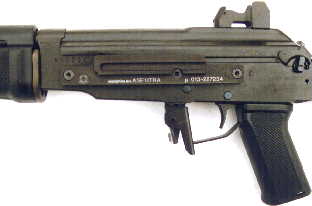
Left side of a M92 assault rifle made by SAKO, Finland. This is
a M95 variant used by Finnish voluntary defence organizations. Left side. Note fixing
points for an accessory Ase Utra scope rail mounted along
the receiver.
What happened to the government orders?
The funding for the FDF is directed from the annual state budget through the Ministry of
Defense. The Finnish defense budget is approximately 1.8 Billion USD, which is some 4.6%
of the total state budget. The FDF uses this funding 50 that around 0.6 Billion USD is
used to procure new material. In 1996 some 16 Million USD were placed in a contract with
SAKO for the new M95 assault rifle. No follow-up orders from the FDF led to a lay off of
some of the workers on the assault rifle line, with more to go in early 1997. From a top
of over 450 workers working with the assault rifle, the force is now down to a hundred ,
and production is facing a grim future.
The "ghost in the curtains" often referred to here is the Finnish Defense Force Hornet
(F/ A18) aircraft procurement from the USA, which depleted most of the funds reserved for other weapons purchases. During the same
period the FDF purchased large amounts of cheap Chinese assault rifles and former DDR used
Russian assault rifles to be placed in stock for the use of all others in units that are
not the best equipped troops of the war time FDF. These cheaper weapons were for use
instead of the order SMG and rifles these forces had. The total wartime force of the FDF
15 some 500,000 soldiers.
The best equipped brigades are already stocked with domestic assault rifles, 50 it seems
there is no need for any further purchases. At least this is a political view of these
matters in many circles. This erroneous impression is probably about to lead to a
situation where the assault rifle production know-how slowly evaporates from Finnish
industry. The staff of Sako are hopeful however. If the Parliament would awaken to
the problem and direct funds for continued production and procurement of domestically
produced weapons, there might be a solution. A previous (13 March 1997) State Cabinet
Defense Political Report regarding development of the Finnish national defense during FY
1998-2007 did not directly secure any hopes for continued funding of the assault rifle.
The debate is ongoing.
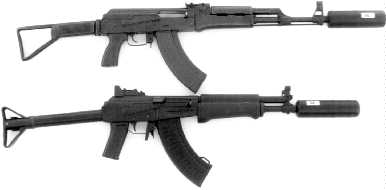
Three assault rifles compared. Above is the 5.56 x 45 mm COLT
M16 with a T4AR suppressor. An AKM variation, the 7.62 x
39 mm Norinco 56S (left above) with a KRS suppressor and
the 7.62 x 39 mm SAKO M62 with a TX4 (left below).
Some light has been shed very recently (in early 1998) On a possible budget for small
scale, up-keep production of the Finnish assault rifle. It has yet to materialize. Patria
Industries Ltd. is a recently formed company including five of the major Finnish
defense materiel related factories; Vihtavuori, Lapua, Sisu Defense, Vammas and
Finnavitec. The key issue, apart from export, is state ownership to secure FDF needs
so SAKO seems to be outside of this procurement. Would there be any sense in purchasing
the assault rifle construction line from SAKO and putting it into the new defense industry
company to save the Finnish assault rifle?
The latest assault rifle - 762 RK 95 TP
The FDF assault rifle 762 RK 62 with its milled receiver will serve well for many decades
to come. It is a reliable and well-made weapon. This previous model is robust, accurate
and well liked by the soldiers using it. The caliber (7.62 x 39 mm) is well suited for use
in Finnish conditions. Small cosmetic adjustments have been made over the years to the
basic assault rifle model but a real FDF demand for a new improved model materialized in
1988 based on research during '86-87. The first SAKO 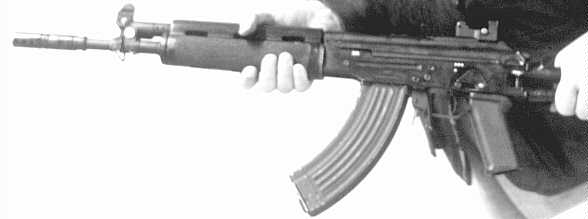 prototypes
of 1988 and 1990 included drastic changes to the rather loud selector lever of the
Kalashnikov type weapons. The selector lever was placed to the left side of the receiver
to be operated with the thumb, and the right side had only a spring assisted cover plate,
instead of the old version, to facilitate charging handle movement and to prevent debris
from entering the receiver.
prototypes
of 1988 and 1990 included drastic changes to the rather loud selector lever of the
Kalashnikov type weapons. The selector lever was placed to the left side of the receiver
to be operated with the thumb, and the right side had only a spring assisted cover plate,
instead of the old version, to facilitate charging handle movement and to prevent debris
from entering the receiver.
A SAKO prototype of the "concept RK90" which was
developed to M95. The selector lever was placed to the left side of the receiver but for
production models it was abandoned in favor of standard Kalashnikov type selector.
For some logistic reason the FDF could not accept this special improvement to the design
so an M92/62 hybrid was constructed for troop field testing purposes. This model was
operated similarly to the M62 and had more interchangeable parts than the previous
prototypes. Sadly, it also had the standard selector. After some small final adjustments
the production model was ordered, and was designated the 762 RK 95 TP by the FDF.
The most important new features of the M95 are;
Folding stock
A very positively locking design folding to the right of the receiver. Stock profile
resembles the Galil but the locking is different. The upper tube of the stock has
an area for maintenance accessories.
Receiver profile and cover assembly
The milled receiver profile is such that it supports the magazine better than the M62
receiver did. The receiver cover is connected to the receiver in the standard Kalashnikov
way but is also secured with a cross bolt through the upper rear of the frame.
Charging handle angle
The handle 15 placed at an upward angle (around 45 degrees) to facilitate left hand
loading. This angle is not as much as that of the Galil.
Gas system valve
The two position (open-closed) valve, is placed under the front sight on the right side.
The actuation lever is well sized and the closed position 15 when the lever is pointing up
(position marked with a "K" and an arrow). The lever is then in view of the
operator. The valve can be of use in different rifle grenade applications or when the need
for the non-retracting bolt carrier is called for- when firing a suppressed rifle.
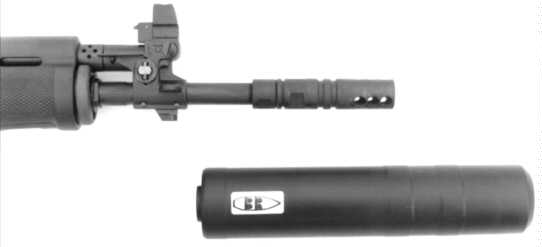
Muzzle brake
This totally new model offers reduced recoil impulse of the rifle, well quenched muzzle
flame and 15 dimensioned for the newest types of rifle grenades. It requires a newly
designed blank firing attachment. The FDF uses wood-bulleted blank ammunition for training
purposes.
An accessory suppressor which quick attaches to the
muzzle brake is produced by another Finnish company.
Sighting systems
The rear sight has an L-shaped foldable peep sight with 150m and 300m settings. In the
middle position the use of the dusk sight 15 possible. The dusk sight 15 an open sight
with a tritium gas self illuminating dot. The elevation and horizontal adjustments are
made to the front sight using an accessory tool. The front sight also has a fold up dusk
sight that has a self illuminating dot. The front sight has protecting ears which clearly
curve forming a circular opening, open at the top. To facilitate use of optical or
optronic sighting devices there 15 an accessory mounting rail that attaches with two
screws to the left side of the receiver.
As a complete weapon the M95 is definitively an improved version of the older M62 with
several other smaller improvements than those described above. The quality of workmanship
is easily seen on any detail. Perhaps the positive acceptance by the troops using these
new rifles and pressure from those not yet issued it, will eventually lead to further
funding, and further procurement of the 762 RK 95 TP by the FDF. The first M95 production
rifle, serial number 960,001, was presented by SAKO to the Military Museum in Helsinki.
Perhaps they will have the good sense to request the absolutely last production rifle
also.
Specifications:
7.62 RK 95 TP (The official FDF model designation)
(7.62 x 39 mm Assault rifle, model 1995, folding stock)
Caliber: 7.62 x 39 mm (5.56 x 45 mm export model also available)
Length: 935 mm, 675 mm (stock folded to the right).
Magazine: Box magazine 30 cartridges, polymer construction. (previous
caliber 7.62 x 39 mm steel magazines fit).
Weight: 4.5 kg with loaded 30 cartridge magazine.
System: Gas operated, rotating bolt. Gas vent has a turnable off / on
valve for special applications.
Cyclic rate: 11 cartridges per second.
Barrel: 420 mm, four rifles 1 turn per 240 mm (has fixing point for
bayonet). Muzzle brake facilitates use of rifle grenades.
Sight: Diopter type 150m/300m settings, flip-up self illuminating open
sights for dusk.
Sight radius: 465 mm. Fixing point for optical and or optronic sight on
left side of receiver.
Standard accessories: Leather sling, six magazines, sight adjustment
tool, gun cleaning kit.
First serial number: 960 001 (Placed in the collections of the Military
Museum, Helsinki)
Made by: SAKO OY, PO Box 149, FIN-11101 Riihimäki, Finland, Phone INT
+358 14 7431 Fax INT +358 14 720 446
Other info: A sporting semi-automatic only M95 rifle with fixed stock has
been produced and marketed.
Remaining products with military potential
What remains in production is the SAKO TRG series of sniping rifles. Two standard
calibers and action sizes are produced; TRG-21 in 7.62 x 51 mm and TRG-41 in caliber 8.6 x
70 mm. The rifle is of modem configuration in the 5 kg range, boasting rugged
subassemblies and a plastic stock. The action is bedded in an aluminum bedding rail, which
in turn functions as the fixing points for the two piece (front and rear) stock. The
handguard part of the two piece stock has mounting rails for accessories. The buttstock
part is fully adjustable for height, length and cant of butt plate. The trigger assembly
is modular, removable and fully adjustable to shooter preferences.
The bolt has three locking lugs offering an opening angle of 60 degrees. The feed is from
a detachable box magazine, 10 cartridges in 7.62 mm and five in 8.6 mm. This rifle has
received positive attention abroad and domestically, but the FDF has not bought it in
quantities other than for sporting use.
There certainly would be a boost of sales potential if SAKO would place a bit more
military attention on this TRG product. Just some fundamental things like applying hard
chrome to the interior of the barrel and other necessary parts.  Perhaps resources are not available, or then again perhaps the SAKO leadership
has become too "sportsman oriented" and is about to lose the military market by
mistake. They would not be the first manufacturer to do this. Be that as it may, this
eventual assault rifle production loss will certainly he Finland's loss.
Perhaps resources are not available, or then again perhaps the SAKO leadership
has become too "sportsman oriented" and is about to lose the military market by
mistake. They would not be the first manufacturer to do this. Be that as it may, this
eventual assault rifle production loss will certainly he Finland's loss.
The 8.6 x 70 mm SAKO TRG41 rifle with a T8M suppressor. (Caliber .338 LAPUA Magnum)
Related links:
Assault rifles page of Reflex Suppressors. Finnish M95 / M92 home pages with rifle accessories.
Gunwriters on the Web story of Finnish M95 website URL: http://guns.connect.fi/gow/M95.html